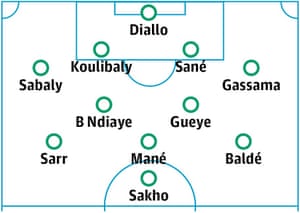This article is part of the Guardian’s 2018 World Cup Experts’ Network, a cooperation between some of the best media organisations from the 32 countries who have qualified for Russia. theguardian.com is running previews from two countries each day in the run-up to the tournament kicking off on 14 June.
Despite guiding Senegal to their first World Cup for 16 years and only their second ever, Aliou Cissé was panned throughout the qualification campaign. Many in the media and in the stands derided the manager’s style as dull and accused him of being too conservative to maximise the potential of a talented squad. But Cissé, a former bustling midfielder and Senegal captain, has never apologised for being pragmatic.
It was perhaps a little ironic, then, that the manager who has been in charge since 2015 was criticised for trying something new during the friendlies in March. The problem, according to critics, was that the introduction of a 3-5-2 system suggested the coach was veering even more towards negativity. The performances in the 1-1 draw with Uzbekistan and the 0-0 with Bosnia-Herzegovina were considered disappointments.
Senegal’s players dismissed the fuss. “Our preferred system is still 4-3-3 or 4-2-3-1 but the coach wanted to try a formation with three centre-backs,” said the most influential of those defenders Napoli’s Kalidou Koulibaly. “And we showed some good things in a set-up to which we are not accustomed.”
One of the few pundits and ex-players who regularly stands up for Cissé is Amara Traoré, who not only played with Cissé at the 2002 World Cup but also knows what it is like to be in his shoes, having managed the Lions of Teranga for three years until 2012. But even Traoré intimated that there has to be a lot of improvement before the experimentation in March can be replicated in a competitive match. “The players didn’t seem clear with it and they played more in a 5-3-2 than a 3-5-2,” he said.
The focus on Cissé is all quite different to 2015, when the public clamoured for him to be appointed in place of the departing Frenchman Alain Giresse. Everyone remembered what an inspirational player he was and he had shown signs of translating that into management when he led Senegal’s under-23s to the quarter-finals of the 2012 Olympics in London. As a leader Cissé has never had any truck with populism so it was no surprise when he dismissed the fussing over a new system in March as silly.
“This system has been around for years,” he said. “It’s not new to me even if it is new to the national team. I’m convinced that some of our players adore it. We will continue working on it. Lots of coaches don’t play this system because it takes a lot of time to get right. That doesn’t mean I’m going to play it at the World Cup. We have other systems that we are suited to.”
Whatever shape he opts for, Cissé seems likely to rely on a defensive solidity and spontaneous magic from individuals, especially Sadio Mané. That is the approach that enabled him to enter history as the first Senegalese manager to lead his country to a World Cup. The public demands that he take the team at least as far as they went in 2002, when, with the Frenchman Bruno Metsu at the helm, Senegal reached the quarter-finals. Failure to at least get out of the group this time, especially if performances are dull, will likely spell an unhappy end to Cissé’s reign.
Probable starting XI

Which player is going to surprise everyone at the World Cup?
Badou Ndiaye. The manager has been reluctant to start him regularly but the Stoke player has impressed in recent matches, bringing extra thrust to central midfield
Which player is likely to disappoint?
Cheikhou Kouyaté. Only because if he is included, it will likely be at the expense of Ndiaye
What is the realistic aim for Senegal at the World Cup and why?
Provided the manager chooses to play to their strengths they could emulate the 2002 team and reach the quarter-finals, at least.
Salif Diallo works for APS.